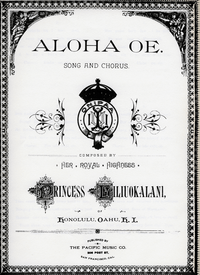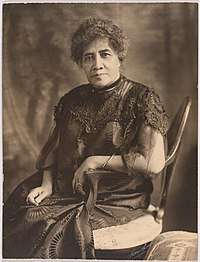Aloha ʻOe
"Aloha ʻOe" (Farewell to Thee) is a Hawaiian popular song written circa 1878 by Queen Liliʻuokalani, who was then Princess of the Hawaiian Kingdom at the time of its composition. It is her most famous song and is a common cultural symbol for Hawaii.


Background
The story of the origin of the song has several variations.[1] They all have in common that the song was inspired by a notable farewell embrace given by Colonel James Harbottle Boyd during a horseback trip taken by Princess Liliʻuokalani in 1877 or 1878 to the Boyd ranch in Maunawili on the windward side of Oʻahu, and that the members of the party hummed the tune on the way back to Honolulu. Different versions tell of alternate recipients of the embrace—either Liliʻuokalani's sister Princess Likelike Cleghorn or a young lady at the ranch.[2] According to the most familiar version of the story:
This tender farewell set Liliʻuokalani to thinking, and she began humming to herself on the homeward trip. Overhearing, Charles Wilson observed, "That sounds like The Lone Rock by the Sea," a comment with which Liliʻuokalani is said to have agreed. When the party paused to rest in an orange grove on the Honolulu side of the Pali, the others joined in the hummings, and the song was completed later at Washington Place.[3]
The Hawaiʻi State Archives preserves a hand-written manuscript[4] by Liliʻuokalani, dated 1878, with the score of the song, the lyrics, Liliʻuokalani's English translation, and her note evidently added later: "Composed at Maunawili 1878. Played by the Royal Hawaiian Band in San Francisco August 1883 and became very popular."
A catalogue issued by Columbia Records in 1901 mentioned two wax cylinders labeled "Vocal Solos in Hawaiian", containing the earlier recordings of "Aloha ʻOe" and "Kuʻu Pua I Paoakalani". However, it is uncertain if this was recorded in Hawaii or if the performer was Hawaiian and the cylinders are now lost.[5] Columbia Records later recorded a duet of the song by Nani Alapai and Henry N. Clark in 1911.[6] A 1913 score can be seen at the Levy Sheet Music Collection.[7]
Lyrics
| Haʻaheo e ka ua i nā pali | Proudly swept the rain by the cliffs |
| Ke nihi aʻela i ka nahele | As it glided through the trees |
| E hahai (uhai) ana paha i ka liko | Still following ever the bud |
| Pua ʻāhihi lehua o uka | The ʻāhihi lehua[lower-alpha 1] of the vale |
| Hui: | Chorus: |
| Aloha ʻoe, aloha ʻoe | Farewell to thee, farewell to thee |
| E ke onaona noho i ka lipo | The charming one who dwells in the shaded bowers |
| One fond embrace, | One fond embrace, |
| A hoʻi aʻe au | Ere I depart |
| Until we meet again | Until we meet again |
| ʻO ka haliʻa aloha i hiki mai | Sweet memories come back to me |
| Ke hone aʻe nei i | Bringing fresh remembrances |
| Kuʻu manawa | Of the past |
| ʻO ʻoe nō kuʻu ipo aloha | Dearest one, yes, you are mine own |
| A loko e hana nei | From you, true love shall never depart |
| Tomago: | Refrain: |
| Maopopo kuʻu ʻike i ka nani | I have seen and watched your loveliness |
| Nā pua rose o Maunawili | The sweet rose of Maunawili |
| I laila hiaʻai nā manu | And 'tis there the birds of love dwell |
| Mikiʻala i ka nani o ka liko | And sip the honey from your lips |
| Hui | Chorus |
Musicology
Parts of "Aloha 'Oe" resemble the song "The Lone Rock by the Sea" and the chorus of George Frederick Root's 1854 song "There's Music in the Air".[8] "The Lone Rock by the Sea" mentioned by Charles Wilson, was "The Rock Beside the Sea" published by Charles Crozat Converse in 1857,[9] and itself derives from a Croatian folk song, "Sidi Mara Na Kamen Studencu" (Girl On The Rock).[10][11]
Notable recordings
- 1911 Nani Alapai and Henry N. Clark – recording for Columbia Records[6]
- 1924 Frank Ferera – this reached the charts of the day.[12]
- 1936 Bing Crosby – recorded July 23, 1936 with Dick Mcintyre and His Harmony Hawaiians.[13]
- 1946 Les Paul and His Trio – recorded March 29, 1946 for Decca Records (catalog No.23685).[14]
- 1957 The King Sisters – for their album Aloha.[15]
- 1959 Andy Williams – included in his album To You Sweetheart, Aloha.
- 1961 Elvis Presley – included in his album Blue Hawaii.
- 1964 The Disneyland Boys Choir - from the Disney LP: It's A Small World.
- 1965 Burl Ives – recorded for his album On the Beach at Waikiki.[16]
- 2002 Tia Carrere – recorded for Lilo & Stitch.[17]
- 2010 Johnny Cash – recorded in 2003, included in his posthumous album American VI: Ain't No Grave
Film appearances
- 1936 Waikiki Wedding – sung by chorus
- 1938 Hawaii Calls
- 1953 From Here to Eternity
- 1961 Blue Hawaii – sung by Elvis Presley
- 2002 Lilo & Stitch – the song is sung briefly by the character Nani Pelekai (voiced by Tia Carrere) as a means to say goodbye to her sister Lilo, as they were going to be separated from each other by then. It is sung again in its franchise's fourth film Leroy & Stitch (2006) by Lilo (Daveigh Chase), Stitch (Chris Sanders), and Reuben (Rob Paulsen) to shut down the Leroy clones.[18][19] The song also appears on the soundtrack of Lilo & Stitch 2: Stitch Has a Glitch (2005).[20]
- 2005 Aloha, Scooby-Doo! – Sung by the Wikki Tikki in the film's climax.
- 2016 Train to Busan – partially sung by one of the main characters, and is also instrumental in the film's conclusion.
In popular culture
The song also plays in many episodes of SpongeBob SquarePants, albeit in instrumental form.
In the episode "Cruise Cat" of the Tom and Jerry in 1952, a guitar version of this song became one of the animation's Background music,[21] and the destination of the liner in the episode was Hawaii.[22]
In the first episode of the 1963 Hanna-Barbera cartoon; Top Cat entitled "Hawaii, Here We Come", at the start of the episode, Benny the Ball sings the song, after winning a free trip to Hawaii, sometime later Officer Dibble also sings the song. They both however replace some of the lyrics with English ones.
"Aloha 'Oe" appeared in the scores of many of Warner Bros.' classic Looney Tunes and Merrie Melodies cartoons, as composer Carl Stalling's stock musical cue for Hawaii-themed gags. Usually instrumental, but Bugs Bunny actually sings one line of the refrain at the very end of Case of the Missing Hare. In the 1953 cartoon short, Duck Amuck part of it is briefly sung by Daffy Duck when the scenery is changed to a Hawaiian setting, courtesy of a sadistic mystery animator and again in A Squeak in the Deep. In the 1958 Oscar-winning short Knighty Knight Bugs, the cartoon ends with an enchanted sword performing an instrumental version of the song (played by a musical saw).
The chorus of the song serves as the intro for Spike Jones' interpretation of "Hawaiian War Chant". ("As the sun pulls away from the shore, and our boat sinks slowly in the west...")
The song also appeared in the Popeye the Sailor short, Alona on the Sarong Seas, where it was played in the beginning of the short, and after Popeye eats his spinach.
In the Japanese anime Space Dandy (created in 2014), the eponymous main character is captain of a spaceship called the Aloha Oe.[23][24]
The Jack London short story Aloha Oe features the chorus of the song.[25]
When Jiang Zemin, then-Chinese President and the General Secretary of the Communist Party of China, arrived at Hawaii at the beginning of his state visit to U.S. in October 1997, he played "Aloha ‘Oe" with a Hawaiian lap steel guitar and invited then Hawaiian First Lady Vicky Cayetano to sing the song at a dinner with the presence of Governor Ben Cayetano. Jiang recounted that he used to frequently play this song when he was in college in 1940s.[26][27]
It also used in the final scene of Train to Busan when Soo-an sings in the tunnel as tribute to her father's sacrifice.
The song is played in the 8th episode of the 8th season of The Simpsons, Hurricane Neddy, when Ned Flanders drives away to the psychiatric hospital.
Notes
- A Hawaiian flower (Metrosideros tremuloides)
References
- The Queen's Songbook, by Her Majesty Queen Liliʻuokalani, Hui Hanai, Honolulu, 1999, pp. 38-39. ISBN 0961673877.
- Wong, Jonathan. "Aloha Oe". Retrieved May 28, 2018 – via Huapala.org.
- Kelsey, Theodore. 1927. "The Queen's Poem — 'Aloha ʻOe,' by Liliuokalani," Paradise of the Pacific 40: 4. Cited in The Queen's Songbook by Her Majesty Queen Liliʻuokalani. Hui Hanai, Honolulu, 1999. Dorothy Kahananui Gillett, text and music notation; Barbara Barnard Smith, Editor. Also, see Aloha Oe Archived 2011-09-28 at the Wayback Machine
- "Translation of "Aloha Oe" handwritten by Liliuokalani, Queen of Hawaii, 1838-1917". gallery.hawaii.gov.
- Schmitt, Robert C. (1978). "Some Firsts in Island Leisure". The Hawaiian Journal of History. Honolulu: Hawaiian Historical Society. 12: 99–119. hdl:10524/376. OCLC 60626541.; Schmitt, Robert C. (1995). "Notes & Queries – TIn Foil and Wax: Hawaiʻi's First Phonograph and Records". The Hawaiian Journal of History. Honolulu: Hawaiian Historical Society. 29: 183–186. hdl:10524/509. OCLC 60626541.
- Bryan, Martin F.; Bryant, William R.; Sears, Roebuck and Company (1975). Oxford and Silvertone records, 1911–1918. St. Johnsbury, VT: New Amberola Phonograph Co. p. 30. OCLC 2593220.
- "151.019 - Aloha Oe. (Farewell To Thee). [English and Hawaiian] - Levy Music Collection". levysheetmusic.mse.jhu.edu.
- "Nalu Music » Aloha 'Oe". www.nalu-music.com. Retrieved May 28, 2018.
- "126.093 - The Rock Beside the Sea. A Romanza. - Levy Music Collection". levysheetmusic.mse.jhu.edu.
- "The Originals: Aloha Oe".
- "YouTube". www.youtube.com.
- Whitburn, Joel (1986). Joel Whitburn's Pop Memories 1890-1954. Wisconsin, USA: Record Research Inc. p. 155. ISBN 0-89820-083-0.
- "A Bing Crosby Discography". BING magazine. International Club Crosby. Retrieved August 12, 2017.
- "The Online Discographical Project". 78discography.com. Retrieved August 12, 2017.
- "Discogs.com". Discogs.com. Retrieved August 12, 2017.
- "Discogs.com". Discogs.com. Retrieved August 12, 2017.
- "World Writing: Poetics, Ethics, Globalization".
- "Lilo and Stitch Aloha 'Oe". wn.com. Retrieved April 4, 2014.
- "Lilo and Stitch Versions of Aloha Oe". History of Hawaii. Retrieved April 4, 2014.
- Phares, Heather. "Lilo & Stitch 2: Island Favorites". All Music. Retrieved April 4, 2014.
- "Cruise Cat Soundtracks". IMDB. 1952. Retrieved September 27, 2018.
- Tom and Jerry Cartoon - Cruise Cat 2015, YouTube, Uploaded on December 1, 2015
- Green, Scott. "Figure Sculptor Makes "Space Dandy" Aloha Oe and QT". Crunchy Roll. Retrieved April 4, 2014.
- Green, Victoria. "'Space Dandy' Recap: A Merry Companion Is a Wagon in Space, Baby". The Celebrity Cafe. Archived from the original on April 7, 2014. Retrieved April 4, 2014.
- London, Jack. The Complete Short Stories of Jack London, Volume 1. Google Books. Retrieved April 28, 2014.
- "President Jiang Zemin of China". partners.nytimes.com. Retrieved March 29, 2016.
- StevenChangHZ (April 19, 2012), 江澤民演奏夏威夷吉他 [Jiang Zemin Playing Hawaiian Guitar], retrieved March 29, 2016
External link
![]()